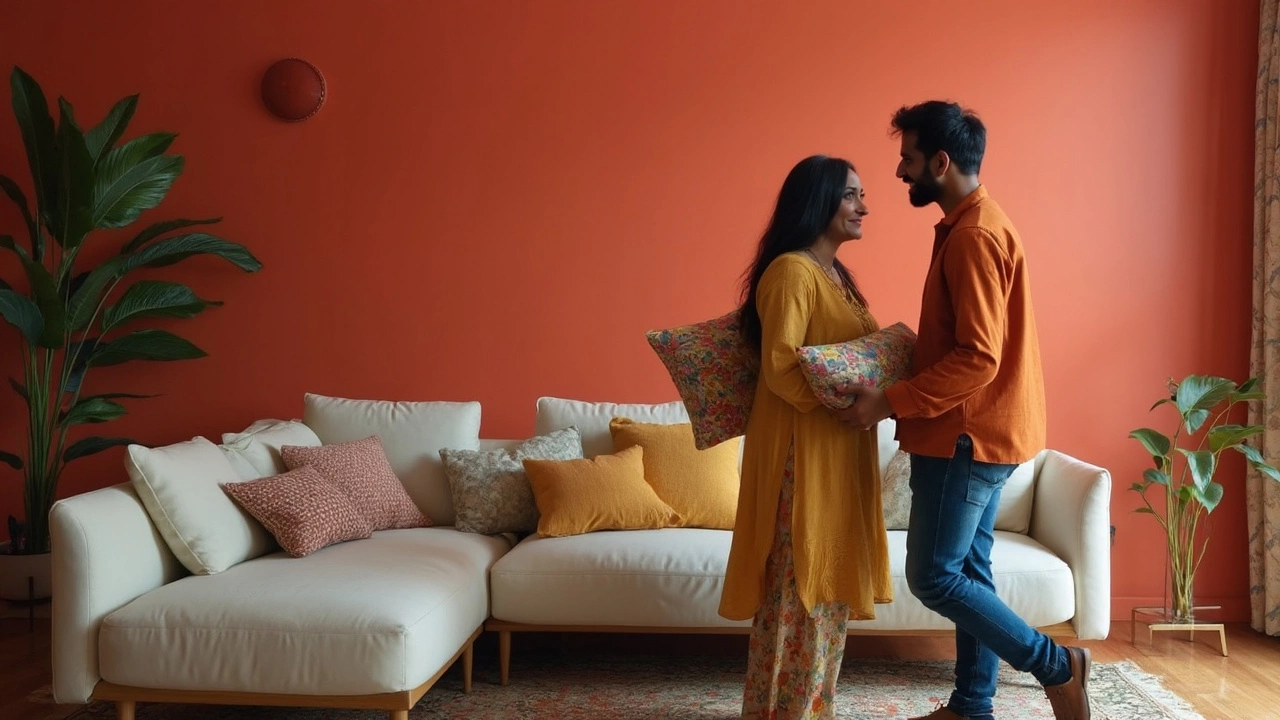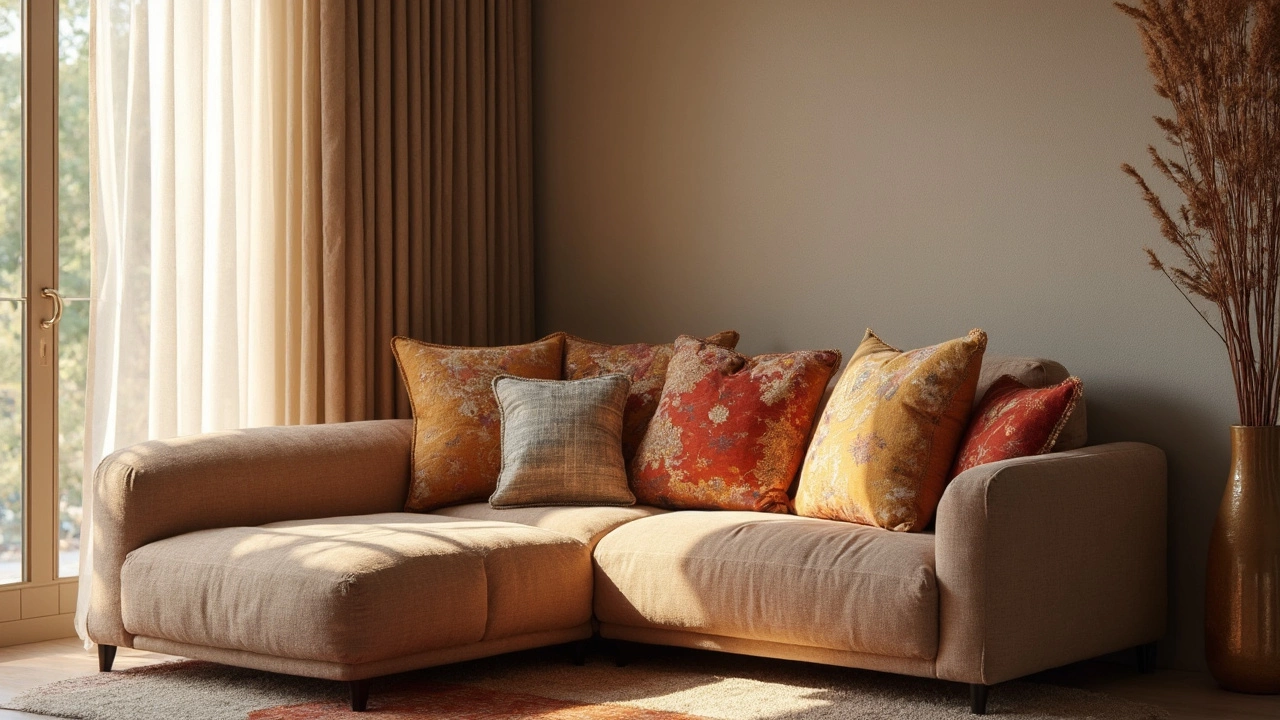If you’ve ever stood in front of a gorgeous corner sofa and wondered, “How many cushions should actually go on this thing?”, you’re far from alone. This isn’t just about buying a pack and tossing them on—there’s a method that helps a corner sofa look balanced, comfy, and not like a pile of lost laundry.
For most people, the sweet spot lands somewhere between five and seven cushions. It depends on your sofa’s size, the vibe you want, and how much lounging you plan to do. A bigger corner sofa obviously soaks up more cushions without looking messy, while a smaller one easily gets drowned out if you go overboard.
Turns out, it’s not just about the number. Think about how the cushions will sit: should they invite you in, or look stylish but stiff? Aim for a mix—a few larger cushions for back support, medium ones for style, and maybe a punchy smaller cushion for a pop of color. This gives you options: prop up, sprawl out, or quickly freshen the look without a trip to the store.
- What Sets a Corner Sofa Apart?
- Counting Cushions: The Sweet Spot
- The Role of Cushion Size and Shape
- Mixing Patterns and Materials
- Styling Tips for Every Room
- Keeping Your Cushions in Place
What Sets a Corner Sofa Apart?
Corner sofas aren’t just bigger—they completely change how you use your living room. Instead of a regular two or three-seater pushed against a wall, a corner sofa opens up the space and helps you squeeze out every bit of seating. It becomes the chill zone during movie marathons, the social hub when friends swing by, and sometimes the only place you want to nap.
What’s cool about a corner sofa is how it fits into awkward spaces, especially if your room isn’t a perfect rectangle. You can tuck it in the corner, stretch it along one wall, or even float it in the middle of the room as a divider. This versatility means you need to think a little differently about how to dress it up, especially when it comes to cushions.
Corner sofas also tend to have a longer “arm” and a shorter one, which adds a twist when arranging cushions. You end up with a main seating area, a cozy nook in the corner, and extra lounging spots along both sides. Most folks use their corner sofa more than any other seat in the house—no surprise, since a UK survey from 2024 found that over 40% of families pick a corner sofa as their main gathering furniture.
Here’s a quick look at why a corner sofa stands out compared to the classic 3-seater:
| Feature | Corner Sofa | Standard Sofa |
|---|---|---|
| Seating Capacity | Up to 7 | Usually 2-3 |
| Fits Odd-shaped Rooms | Yes | No |
| Works as Room Divider | Yes | Rarely |
| Customisable Layouts | Lots (L-shape, U-shape, modular) | Few options |
The main thing? A corner sofa turns your living room into a flexible, all-in-one hangout—so the way you use cushions on it won’t be the same as a normal couch. You’re working with more space, more angles, and way more ways to kick back.
Counting Cushions: The Sweet Spot
Figuring out the ideal number of cushions for your corner sofa isn’t an exact science, but there’s a strategy behind it that just makes sense. You want your sofa to look inviting, not chaotic. Most experts and furniture brands suggest a range of five to seven cushions for a typical corner sofa—that’s the number you’ll spot most often in design magazines or furniture showrooms.
It’s actually about how those cushions are spaced, too. Throw all seven on one side, and the other side looks bare. Spread them out evenly, and you’re in that sweet spot between stylish and comfortable. If your sofa’s got a long main section with a shorter side, use more cushions on the longer part and just one or two on the short side or "chaise" bit.
- For smaller 2 or 3-seater corner sofas: Stick with 4-5 cushions so you leave space to actually sit.
- Bigger, 4-5 seater sofas can easily handle 6-8 cushions without it turning into a cushion avalanche.
- You can even go minimal with 3 or maximalist with 9, but those are bold looks that not everyone loves.
Here’s a breakdown of how different setups might look, based on sofa size:
| Corner Sofa Size | Recommended Cushions | Notes |
|---|---|---|
| Small (2-3 seater) | 4-5 | Keep it clear for sitting space |
| Medium (3-4 seater) | 5-7 | Balance both sides |
| Large (4-5+ seater) | 6-8 | Go bold—show off your style |
If you have pets or kids that love tossing pillows around, stick to the lower side of the range—otherwise, you’ll spend half your life picking cushions off the floor. If you’re after that cozy, "curl up and binge-watch" feeling, leaning toward the higher end works great—just make sure there’s still a place to sit without feeling crowded.
The Role of Cushion Size and Shape
The size and shape of your cushions are just as important as how many you put on your corner sofa. They control both the look and how comfortable your seating feels. Get these details wrong and you risk either making your sofa look overcrowded or oddly empty, even with the right number of cushions.
Start with the basics: cushion sizes. The most common square cushion is around 45x45cm (about 18x18 inches)—that’s your typical all-rounder. Bigger square ones run about 60x60cm and work really well as base layers at each end of the sofa’s arms. For corner sofas with deep seats or wide arms, these larger sizes give proper support for anyone leaning back.
Shapes matter, too. Squares are easy and fit nearly anywhere, but mixing in a rectangular (or lumbar) cushion—think 30x50cm or 12x20 inches—breaks up the look and adds extra back support. Round cushions (maybe 40cm across) or small bolsters can work, especially if you want to soften up sharp corners or create a cozier spot in the corner seat. A good mix means your sofa feels thoughtfully styled, not thrown together.
Here’s a quick table of common cushion sizes and their usual roles:
| Shape | Common Size | Best For |
|---|---|---|
| Square | 45x45cm (18x18 in) | Standard mix; back support; layering |
| Large Square | 60x60cm (24x24 in) | Ends of sofa; deep seats |
| Rectangle/Lumbar | 30x50cm (12x20 in) | Lower back support; style accents |
| Round/Bolster | 40cm (16 in) diameter | Corner seat; softening lines; decor pop |
If you’re unsure, try ‘the triangle trick’: stack two large square cushions at each end, add a smaller square or rectangle in front, then toss in a funky round cushion near the corner. It looks styled but relaxed—and it welcomes people to actually use the space. Just watch out for cushions that are too big for your sofa; they’ll hog the seat and get tossed aside fast.

Mixing Patterns and Materials
Don’t let your corner sofa look flat and boring by playing it safe with just one color or fabric. If you pick cushions that all match perfectly, the space can end up looking stiff. Throwing in a mix of patterns, colors, and textures keeps things interesting and personal—it’s the easiest way to make the room feel lived-in and stylish without trying too hard.
Patterns aren’t just about wild prints—try checks, stripes, florals, or even something subtle like a diamond weave. The trick is to pick a main color that matches your sofa or room, then add two or three accent patterns so nothing feels out of place. Here’s a neat trick: stick to odd numbers when picking patterned versus solid cushions, like three solids and two patterns, or vice versa. This stops any one look from dominating.
- If your sofa is a neutral shade like grey, cream, or beige, go bold with some of your cushions—think mustard, navy, or forest green for energy.
- Mix in at least one textured cushion, like velvet or chunky knit, to break up all the smooth or shiny fabrics.
- Don't be afraid to toss in a leather or faux fur cushion. They stand up to wear, and give a cool, mixed look that feels high end—even if you’re working with a budget.
You don’t want everything clashing. Try this quick check: lay your cushion choices on the floor in front of the sofa. Step back and look. If your eye keeps bouncing around and you feel confused, try swapping one or two for something plainer.
| Material | Durability (1-10) | Comfort Level | Easy To Clean? |
|---|---|---|---|
| Cotton | 7 | Soft | Yes |
| Velvet | 6 | Very Soft | No |
| Leather/Faux Leather | 8 | Firm | Yes |
| Chunky Knit | 5 | Cozy | No |
| Linen | 7 | Cool/Light | Yes |
Patterns and materials not only change the look—they affect how your sofa feels, too. Swap them out with seasons: throw in a faux fur or chunky knit for winter, switch to linen or cotton for summer. If you’re shopping, check the material’s cleaning tag. Velvet, for example, is great for comfort but attracts dust, while cotton or linen just need a toss in the wash.
Styling Tips for Every Room
The sweet spot when styling a corner sofa is matching your cushion setup with the mood and use of your space. What feels cozy in a family room might look out of place in a modern city apartment. Here’s how to get it right no matter what your space looks like.
Family Room: Go for durability and comfort. Machine-washable covers or tough fabrics like canvas work best if kids or pets are in the mix. Earth tones and chunky weaves add warmth and hide signs of daily life better. Use at least five cushions, mixing two large (22-inch) for the back with smaller ones for the sides.
Open-Plan Living Spaces: Keep things visually tidy. Use three to five medium-sized cushions with matching or neutral covers so the sofa blends with the adjoining kitchen or dining room. Don’t let patterns fight with your rugs or curtains—stick to simple textures like linen or velvet here.
Modern Apartments: Low-profile, compact cushions in bold colors or geometric patterns make a statement without cluttering limited space. Two or three are usually plenty, and asymmetry sometimes looks better—style them unevenly in one corner for a cool, relaxed vibe.
Formal Living Rooms: Want the hotel-lobby look? Go symmetrical with pairs of matching cushions (think two of each kind) in velvet, silk, or classic patterns like stripes. Use inserts one size up from your covers for that plump, polished look designers swear by.
Quick cheat sheet—here's how most people split their sofa setup, according to a 2024 survey by HomeStyle Trends:
| Room Type | Average Number of Cushions | Popular Cushion Material |
|---|---|---|
| Family Room | 6 | Cotton/Canvas |
| Open-Plan Living | 4 | Linen/Velvet |
| Modern Apartment | 3 | Polyester/Minimalist Cotton |
| Formal Living | 5 | Silk/Velvet |
Also, whatever the room, resist the urge to line up all your cushions military-style. A quick toss or one-off angle always makes the sofa look more inviting. And don’t be afraid to swap covers with the seasons—cool blues for summer, warm mustards or reds for winter. You don’t need a new sofa to change the whole feel of your space, just smart cushion choices tailored to the way you live.
Keeping Your Cushions in Place
Nothing wrecks the look of your corner sofa faster than cushions that constantly slip and slide. It gets annoying, especially with kids or pets in the mix, or when you want the sofa to stay photo-ready. Before you give up and stick with one sad cushion, here’s what actually works for keeping those cushions where you want them.
The big reason cushions go walkabout is slick fabric. If your sofa or cushion covers feel smooth—like leather, faux leather, or silky polyester—they’ll move around more. For fabric sofas, cushions usually stay put longer, but even those can shift after a movie marathon. Corner sofas are notorious for cushion pile-ups in the inner corner, so managing placement matters.
- Non-slip Mats or Pads: Cut-to-size shelf liners or rug pads between the cushion and the sofa work wonders. They’re cheap, invisible, and actually solve the problem fast.
- Velcro or Hook-and-Loop Tape: Stick one side to the cushion and one to the sofa. Press together, and that cushion isn’t budging unless you want it to.
- Weighted Cushions: Some brands sew tiny weights into corners or use heavier filling. You won’t notice the weight, but your cushions will stay put.
- Anti-Slip Cushion Covers: These have little grippy dots or rubberized backings on one side. Perfect if you want to change covers often without fussing with sticky tape.
- Pillow Arranging: Don’t stack all your cushions in the corner or at one end. Spread them out and overlap a couple slightly, so the edges wedge together and create more friction.
Most people don’t realize how much time they spend fixing cushions. In a UK home survey from 2023, the average person adjusted their sofa cushions three times a day. That adds up to more than 1,000 times a year.
| Method | Effectiveness Rating (1-5) | Cost Range (£) |
|---|---|---|
| Non-slip Mats | 4.7 | 5-10 |
| Velcro Tape | 4.5 | 3-8 |
| Weighted Cushions | 3.9 | Extra 5-15/cushion |
| Anti-Slip Covers | 4.2 | 8-20/cover |
One more quick tip: Deep seats? Go for larger, denser cushions that fill the space so there’s less wiggle room. For everyday lounging, keep a non-slip pad under your most-used cushions—like the ones in the corner or along the back. Combine two of these methods and you’ll only need to straighten things up before you have guests over. Problem solved.

